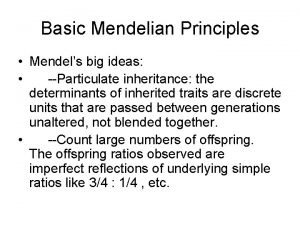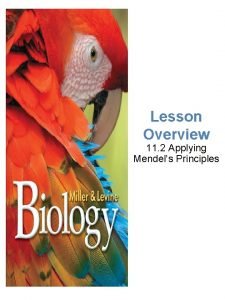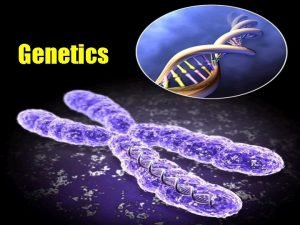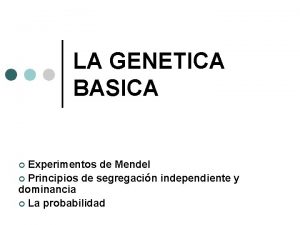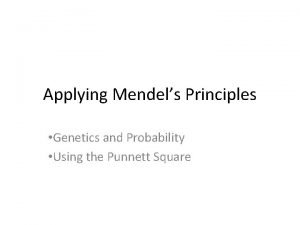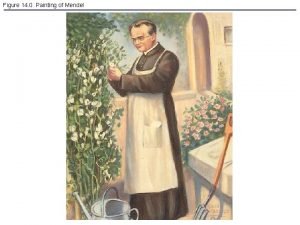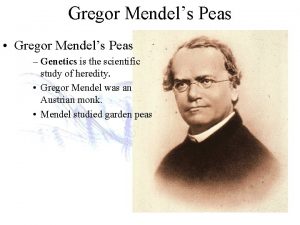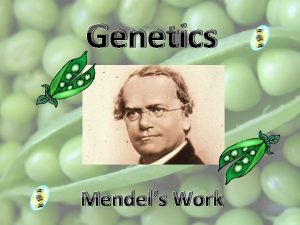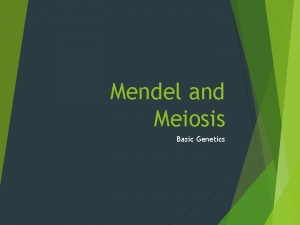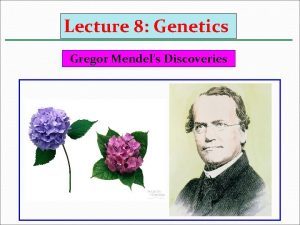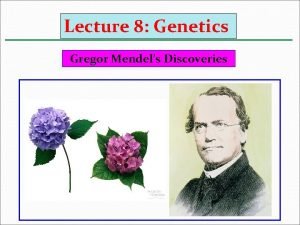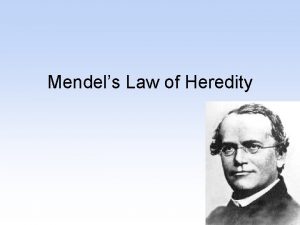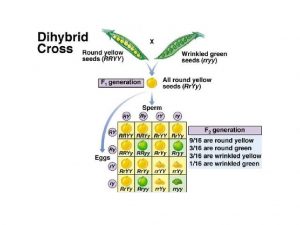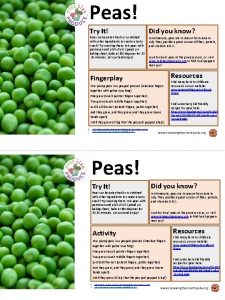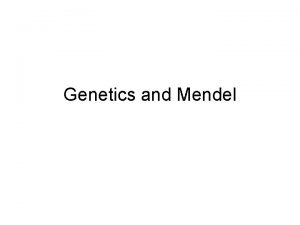11 1 The Work of Gregor Mendels Peas




















- Slides: 20

11 -1 The Work of Gregor Mendel’s Peas Genetics is the scientific study of heredity. Gregor Mendel work was important to the understanding of heredity. - He worked with garden peas. Slide 1 of 32 Copyright Pearson Prentice Hall End Show

11 -1 The Work of Gregor Mendel’s Peas Mendel knew that • the male part produces pollen, (sperm). • the female part produces egg cells. Slide 2 of 32 Copyright Pearson Prentice Hall End Show

11 -1 The Work of Gregor Mendel’s Peas Mendel had true-breeding pea plants. True breeding means that if they would produce offspring they would be identical to themselves. Slide 3 of 32 Copyright Pearson Prentice Hall End Show

11 -1 The Work of Gregor Mendel’s Peas This process is called crosspollination. Mendel was able to produce seeds that had two different parents. Slide 4 of 32 Copyright Pearson Prentice Hall End Show

11 -1 The Work of Gregor Mendel Genes and Dominance A trait is a specific characteristic that varies from one individual to another. Example: seed color, flower color. Mendel studied seven pea plant traits, each with two contrasting characters. Slide 5 of 32 Copyright Pearson Prentice Hall End Show

11 -1 The Work of Gregor Mendel Genes and Dominance Each original pair of plants is the P (parental) generation. The offspring are called the F 1, or “first filial, ” generation. The offspring of crosses between parents with different traits are called hybrids. Slide 6 of 32 Copyright Pearson Prentice Hall End Show

11 -1 The Work of Gregor Mendel Genes and Dominance Mendel’s F 1 Crosses on Pea Plants Slide 7 of 32 Copyright Pearson Prentice Hall End Show

11 -1 The Work of Gregor Mendel Genes and Dominance Mendel’s Seven F 1 Crosses on Pea Plants Mendel’s F 1 Crosses on Pea Plants Slide 8 of 32 Copyright Pearson Prentice Hall End Show

11 -1 The Work of Gregor Mendel Genes and Dominance Mendel's first conclusion: biological inheritance is determined by factors that are passed from one generation to the next. These traits are passed on via genes. Genes are factors that determine traits. Different forms of a gene are called alleles. Slide 9 of 32 Copyright Pearson Prentice Hall End Show

11 -1 The Work of Gregor Mendel Genes and Dominance Mendel’s second conclusion; The principle of dominance: some alleles are dominant and others are recessive. Slide 10 of 32 Copyright Pearson Prentice Hall End Show

11 -1 The Work of Gregor Mendel Genes and Dominance An organism with a dominant allele for a trait will always exhibit that form of the trait. An organism with the recessive allele for a trait will exhibit that form only when the dominant allele for that trait is not present. Slide 11 of 32 Copyright Pearson Prentice Hall End Show

11 -1 The Work of Gregor Mendel Segregation Mendel suggested that the alleles for tallness and shortness in the F 1 plants segregated from each other during the formation of the sex cells, or gametes. Slide 12 of 32 Copyright Pearson Prentice Hall End Show

11 -1 The Work of Gregor Mendel Segregation Alleles separate during gamete formation. Slide 13 of 32 Copyright Pearson Prentice Hall End Show

11 -1 Click to Launch: Continue to: - or - Slide 14 of 32 End Show Copyright Pearson Prentice Hall

11 -1 Gametes are also known as a. genes. b. sex cells. c. alleles. d. hybrids. Slide 15 of 32 End Show Copyright Pearson Prentice Hall

11 -1 The offspring of crosses between parents with different traits are called a. alleles. b. hybrids. c. gametes. d. dominant. Slide 16 of 32 End Show Copyright Pearson Prentice Hall

11 -1 In Mendel’s pea experiments, the male gametes are the a. eggs. b. seeds. c. pollen. d. sperm. Slide 17 of 32 End Show Copyright Pearson Prentice Hall

11 -1 In a cross of a true-breeding tall pea plant with a true-breeding short pea plant, the F 1 generation consists of a. all short plants. b. all tall plants. c. half tall plants and half short plants. d. all plants of intermediate height. Slide 18 of 32 End Show Copyright Pearson Prentice Hall

11 -1 If a particular form of a trait is always present when the allele controlling it is present, then the allele must be a. mixed. b. recessive. c. hybrid. d. dominant. Slide 19 of 32 End Show Copyright Pearson Prentice Hall

END OF SECTION
 What is this process called
What is this process called Gregor mendel plant
Gregor mendel plant In the punnett square shown in figure 11-1
In the punnett square shown in figure 11-1 Chapter 12 lesson 1 the work of gregor mendel
Chapter 12 lesson 1 the work of gregor mendel Chapter 11 the work of gregor mendel
Chapter 11 the work of gregor mendel Section 11-1 the work of gregor mendel
Section 11-1 the work of gregor mendel Chapter 12 lesson 1 the work of gregor mendel
Chapter 12 lesson 1 the work of gregor mendel Chapter 12 lesson 2 applying mendels principles
Chapter 12 lesson 2 applying mendels principles Mendels fabric
Mendels fabric Law of segregation meiosis
Law of segregation meiosis Gregor mendel mbti
Gregor mendel mbti Mendels first law
Mendels first law Applying mendel's principles
Applying mendel's principles Phenotype and genotype
Phenotype and genotype Mendels law of segregation states that
Mendels law of segregation states that 3 laws of inheritance
3 laws of inheritance Freckles punnett square
Freckles punnett square Resultados
Resultados Applying mendels principles
Applying mendels principles Chapter 12 lesson 2 applying mendel's principles
Chapter 12 lesson 2 applying mendel's principles Mendels law
Mendels law








